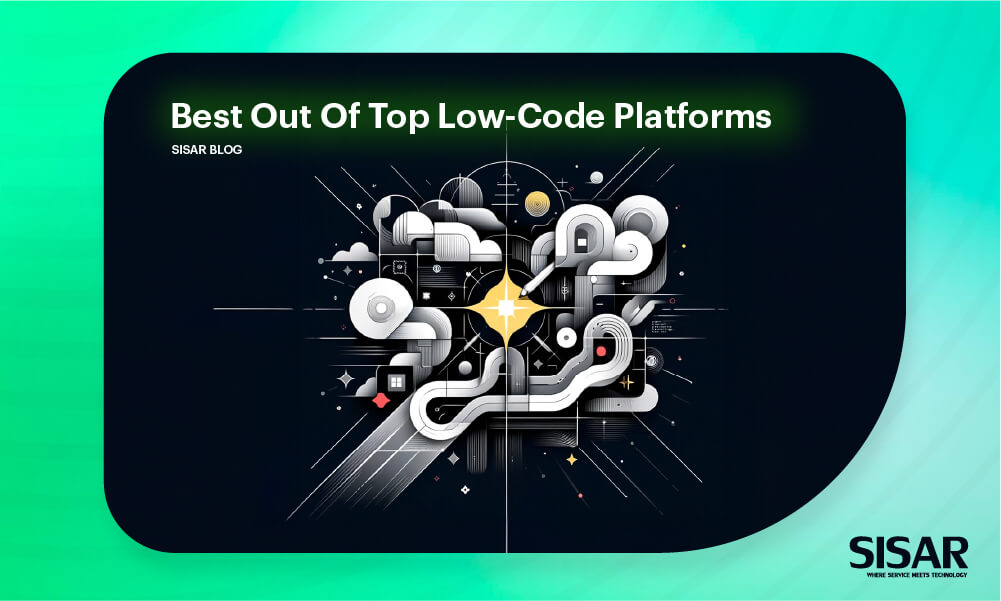In today’s fast-paced digital world, businesses are always looking for ways to streamline their rapid development. In the meantime, they maintain quality and functionality. This has led to the rise of low-code platforms, which allow users to build applications with minimal manual coding.

Low-code platforms save time and align with business goals and objectives, streamlining the development process.
However, with so many options, choosing the right low-code platform can be a challenge. But don’t worry, we’ll walk you through the process step by step.
Low-code platforms dramatically change software application development. They make coding more accessible to a wider range of team members. This includes project managers without expertise in traditional programming languages.
As a result, a diverse group can contribute to software projects. This approach broadens the base of contributors and innovators within organizations.
By leveraging these platforms, organizations can utilize automated processes to simplify the creation and deployment of applications, reducing reliance on complex coding tooling.
This approach speeds up development timelines. It also makes application development accessible to all. This allows team members from various departments to contribute ideas and solutions.
As a result, code development platforms are now essential in modern software development. They enable faster innovation. They also support more collaborative workflows.
1. Understanding Your Requirements for finding a low-code platform
Before diving into the sea of low-code platforms, it’s crucial to understand your specific needs and objectives. Ask yourself:
- What type of applications do you intend to build? Are they web-based, mobile apps, or both? Take into account the intricacy and magnitude of your projects.
- What level of personalization and growth potential do you require? Will your applications need to handle a large volume of users or data? Assess your growth projections and growth potential needs.
- What integrations are necessary for your workflow automation? Do you need to connect with existing databases, APIs, or other software? Consider the compatibility of the low-code platform with your existing tech stack.
- What is your budget for the platform? Take into consideration not just the initial expenses but also the continuous maintenance and support fees. Evaluate the return on investment (ROI) based on your budget constraints.
2. Researching Available Options
Top Low-code platforms in the market
Microsoft Power Apps – Low-code:
Microsoft Power Apps is a leading low-code platform. It seamlessly integrates with Microsoft’s ecosystem. Power apps also has robust features and a user-friendly interface.
It offers a wide range of templates and pre-built components to expedite development. With Power Apps, users can quickly create custom apps for different business objectives. These needs include data visualization, process automation, and customer engagement.
Mendix – Low-code
Mendix is a popular choice for enterprise-level applications. It offers advanced features like AI integration and extensive collaboration tools. Its drag-and-drop interface makes it accessible to both developers and business users.
Mendix’s visual development environment enables rapid prototyping and iteration, empowering teams to deliver high-quality applications with speed and agility.
OutSystems – Low-code
OutSystems boasts a comprehensive set of tools for building and deploying enterprise-grade applications rapidly. Businesses favor it for its visual development environment. Built-in security features add to its appeal.
This makes it popular among businesses with strict compliance needs. These businesses often have to meet high standards. The combination of visuals and security meets these standards well.
With OutSystems, organizations can accelerate digital transformation initiatives and deliver personalized user experiences across web and mobile channels.
Appian – Low-code
Appian stands out for its powerful process automation capabilities. This makes it ideal for businesses that want to streamline their workflows. It offers a low-code development environment coupled with advanced BPM (Business Process Management) features.
With Appian, organizations can automate manual tasks, optimize business processes, and drive operational efficiency across the enterprise.
3. Evaluating Key Features of low-code platform
Once you’ve narrowed down your options, it’s time to delve deeper into the features offered by each platform. Some key features to consider include:
- Drag-and-drop interface for rapid development:
For rapid development, evaluate how easy and flexible the platform’s visual development tools are. These tools include a drag-and-drop interface.
- Integration capabilities with third-party systems and services:
Evaluate the platform’s compatibility with your existing infrastructure and integration requirements.
- Mobile optimization for cross-platform compatibility:
Ensure that the platform supports responsive design and native mobile app development.
- Growth potential to accommodate future growth:
Consider the platform’s growth potential features, such as multi-tenancy support and horizontal scaling.
- Security measures to protect sensitive data:
Look for built-in security features, such as data encryption, role-based access control, and compliance certifications.
4. User Experience Assessment
Low-code platforms offer simplicity, which is one of their primary advantages. They are easy to use. This is true even for users with minimal coding experience. Test-driving each platform through free trials or demos can help you gauge:
- Ease of use of the interface:
Evaluate the user experience and design aesthetics of the platform’s development environment.
- Availability of tutorials and documentation:
Look for comprehensive documentation, tutorials, and community resources to support learning and troubleshooting.
- Support for collaborative development:
Assess the platform’s collaboration features, such as version control, team-based development, and real-time collaboration tools.
5. Considering Growth Potential and Flexibility
While your immediate needs may be modest, it’s essential to choose a platform that can scale alongside your business. Look for:
- Support for complex workflows and business logic:
Evaluate the platform’s capabilities for modeling and automating complex business processes.
- The capability to enhance functionality using custom code is one aspect:
Consider whether the platform allows for custom scripting or integration with external libraries and frameworks.
- Options for on-premises or cloud-based deployment:
Assess the platform’s deployment options and growth potential features, such as auto-scaling and high availability.
6. Reviewing Customer Feedback
Nothing beats real-world experiences when it comes to assessing the performance and reliability of a low-code platform. Browse through user reviews and Customer reviews to gain insights into:
- Reliability of the platform’s infrastructure:
Evaluate the platform’s uptime, performance, and reliability based on user feedback and industry benchmarks.
- Responsiveness of customer support:
Assess the quality of the platform’s customer service team. Consider their responsiveness, including their expertise and availability. Also, look at their turnaround time for resolving issues.
- Overall satisfaction with the platform’s features and performance:
Look for patterns in user feedback, such as common pain points or areas of strength, to inform your decision-making process.
7. Calculating Total Cost of Ownership
Low-code platforms can significantly cut down on development time and costs. However, it’s important to consider the total cost of ownership (TCO) as well.
This involves looking at the long-term expenses. Understanding these costs helps in making a more informed decision. Factors to include in your calculations are:
Subscription fees or licensing costs:
Evaluate the pricing plans and licensing options offered by each platform. Consider any additional charges for premium features. Also, look into extra costs for support.
Additional expenses for development and maintenance:
Consider the costs associated with hiring developers, training staff, and ongoing maintenance and support.
Potential savings in development and maintenance expenses:
Compare the estimated costs of building applications with traditional development methods versus using a low-code platform.
Also, compare the maintenance costs. Consider factors like time-to-market. Think about productivity gains. Factor in resource efficiency as well.
Navigating the low-code landscape necessitates a strategic approach, informed by a thorough understanding of your organizational needs and meticulous evaluation of available platforms.
By leveraging the insights from this comprehensive guide, you can start your quest confidently. Your goal is to find the perfect low-code platform. This guide aims to assist you in making a well-informed decision.
Whether you choose Microsoft Power Apps, Mendix, OutSystems, Appian, or another contender matters. The chosen platform will act as a catalyst for innovation.
It will propel your organization towards digital transformation. This leads to sustainable growth. Each option offers unique benefits to consider.
Remember, selecting a platform is just the beginning of the journey. Embrace continuous learning and adaptation. This approach will help you maximize the full potential of your chosen low-code solution.
Conclusion – Low-code
Finding the perfect low-code platform requires careful consideration of your specific requirements, available options, and key features. By following the steps in this guide, you can start your selection process.
Conduct thorough research as part of these steps. This will lead to a confident choice of platform. Choose one that empowers your team to be innovative. Aim for a platform that lets you build applications efficiently and effectively.
Remember, the aim isn’t just to find any low-code platform. It’s about finding the one that best matches your business goals.
This platform should align with your specific objectives. So, take your time and explore your options carefully. Make an informed decision.
This decision should set your organization up for success in the digital age. Whether you choose Microsoft Power Apps, Mendix, OutSystems, Appian, or another option matters. The right low-code platform can change your development process.
It can make things faster and more efficient. This choice can drive your business forward. Consider what each platform offers to find your best fit.






